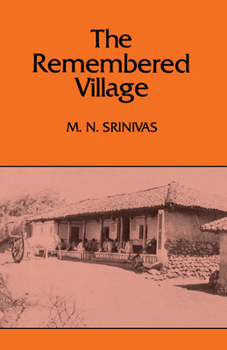The Remembered Village: Volume 26
(Part of the Center for South and Southeast Asia Studies, UC Berkeley Series)
Select Format
Select Condition 
Book Overview
"The real virtue of this most recent contribution by Dr. Srinivas is the consistently human, humane, and humanistic tone oft he observations and of the narration; the simple, straightforward style in which it is written; and the richness of anecdotal materials. . . . He writes modestly as a wise and knowledgeable man. He restores faith in the best tradition of ethnography. Without being popular, in the pejorative sense, it is a book any uninitiated...
Format:Paperback
Language:English
ISBN:0520039483
ISBN13:9780520039483
Release Date:June 1980
Publisher:University of California Press
Length:392 Pages
Weight:1.07 lbs.
Dimensions:1.0" x 5.5" x 8.6"
Customer Reviews
2 ratings
An engrossing book by M.N.Srinivas
Published by Thriftbooks.com User , 20 years ago
I had never heard of M.N.Srinivas before seeingthis book, since I am an not a "humanities" person,and Srinivas is apparently India's most distinguishedanthropologist, well-known mostly in academic circles.The book is an account of life in Rampura, a village nearMysore in South India in the year 1948: it describes in detailpeople, customs and relationships in this village ofabout 1500 people. It reads like a long, engrossingstory, with only occasional lapses into academic language.Srinivas spent the year of 1948 doing "field work" in Rampura,a village about 20 miles from Mysore. His goal was to researchand document village life from a social anthropologist's pointof view. Srinivas himself is a well-off, progressive Brahminfrom the big town (Mysore) and shares almost nothing withthe villagers. He views the village and its customswith the inquisitive curiosity of an outsider -- which makeshis perspective valuable for the modern reader. However, Srinivas' perspective and sympathies are uniquely Indian, and cannot be duplicated by Western researchers writing on the same subject.After spending the entire year living among the villagers,eating, sleeping and going to the toilet like them, heestablishes deep bonds with the village, which lead on torepeated visits in later years. Throughout the book emergethe simplicity and innocence of the villagers, alongsidetheir often contradictory earthy and religious sides.Though Srinivas occasionally provides his own perspectives, hedoes not allow these to interfere with the raw descriptionof his days, at once hilarious and touching, in the rememberedvillage.The book has too many important insights into Indian village lifeto list. You will have to read it yourself to enjoy them.People who understand Kannada will enjoy this book even morebecause they may be able to relate to some of the typicalvillage expressions (sometimes written alongside in parantheses).However, the book is by no means accessible to the reader fromKarnataka alone. In fact, it manages a unique balance betweengenericity and specificity. It would have been even nicer ifSrinivas had published some of the very many photographs hereports he took of the village and the villagers; one hopesthat future editions of this book will try and include them.A book such as this can only become more valuable with thepassage of time. It is a must-read for the modern Indianreader, especially the urban reader. It will make Indiansunderstand better the parts of their culture which haveroots in the villages. I wish such books existed aboutall regions in all parts of the world: it is the perfectkind of book to read about a culture one doesn't fullyunderstand -- even one's own.
Warm, in-depth portrait of a Karnataka village in 1948
Published by Thriftbooks.com User , 24 years ago
Neither anthropologists nor men come much better than M.N. Srinivas, who passed away not long ago. One of the first Indians to write on the ethnography of his own country, he studied in England with both Radcliffe-Brown and Evans-Pritchard, now deities in the hagiography of Anthropology. Back in 1948, Srinivas studied a village in what was then Mysore state, investigating everything he could, from agriculture to caste relationships, from religion to village politics. It was the classic style of field study. In succeeding years, Srinivas published a large number of important articles and several books, including "Religion and Society among the Coorgs of South India", "Caste in Modern India and other essays" and "Social Change in Modern India". He never actually got around to writing up his old village study. In 1970, he was a fellow at Berkeley and finally was about to finish the work. An arsonist burned his office and all three copies of the work. THE REMEMBERED VILLAGE, then, is literally "remembered" because the bulk of the work went up in flames, though some notes were saved and the original data was in Delhi. What emerges is a wonderful portrait of an Indian anthropologist's time in the field, his relationship with the various villagers, and a lovingly detailed picture of the village itself, covering all the usual aspects of an anthropological study. Perhaps adversity and misfortune combined to produce a greater work. As an anthropologist who has worked on India for many years and as a person who was impressed with the warmth and humanity of Prof. Srinivas (though I only met him briefly many years ago in Australia), I strongly recommend this book to anyone who wants to know the feel, the look, and the inner workings of an Indian village back in the days before the Green Revolution, television, and globalisation. This is Anthropology without jargon, India from the inside.





